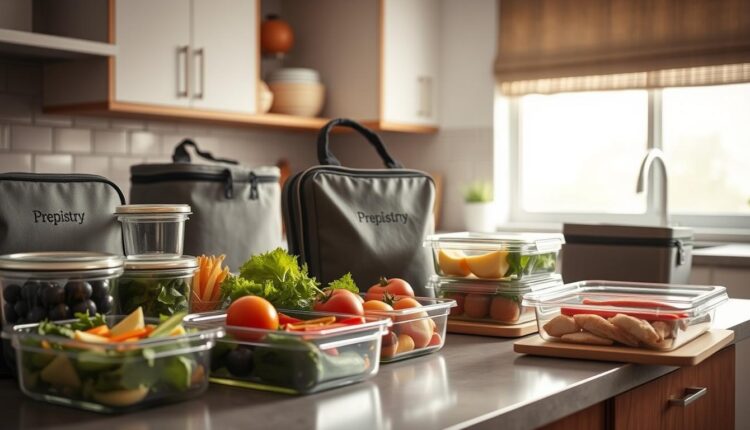Lunch Meal Prep Food Safety For Unrefrigerated Hours
Keep your lunch meal prep safe with our comprehensive guide. Learn the best practices for handling unrefrigerated meals and ensure food safety.
Busy schedules demand smart solutions. I learned this the hard way when my carefully packed quinoa bowls turned questionable after sitting in a conference room all morning. That’s when chefs like Ben Ebbrell and meal prep enthusiasts like Sean Willers became my guides to creating safe, portable dishes.
Smart planning isn’t just about saving time or money—though batch cooking does both. It’s about understanding how ingredients behave at room temperature. For example, Willers swears by pre-chilled containers and strategic layering to keep components crisp until noon. These small adjustments prevent soggy veggies and maintain flavor without constant refrigeration.
Key Takeaways
- Strategic cooling methods extend freshness for hours
- Proper container selection prevents temperature swings
Through trial and error (and a few too many wilted salads), I’ve discovered techniques that work for real life. Let’s explore how simple shifts in preparation can transform your approach to midday nourishment—no ice packs required.
the Basics of Meal Prep Food Safety
We’ve all opened a container to find mysterious fuzz or an off smell. That moment teaches more about kitchen science than any textbook. Let’s break down what actually keeps your creations fresh—and safe—when life keeps you away from the fridge.
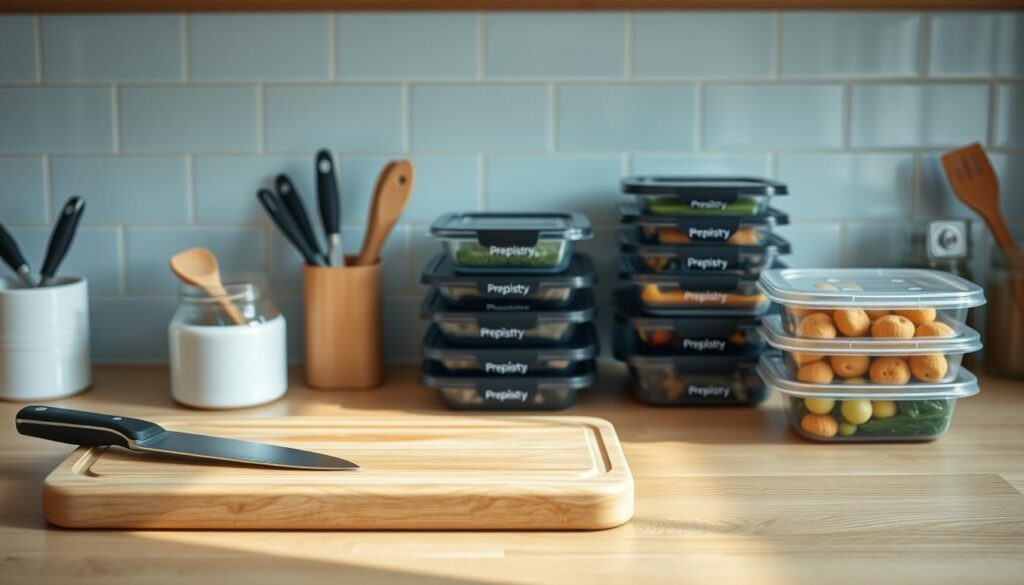
Spot Trouble Before It Starts
Your nose knows first. Sour odors, slimy textures, or color changes signal it’s time to toss. Nutritionist Isobel Baillie Hamilton notes, “Bacteria thrive between 40°F and 140°F—the exact range your chicken salad hits during a morning meeting.”
Cooked grains like rice demand extra care. They spoil faster than most proteins if left warm. Always cool them completely before sealing containers. A pro tip? Spread hot items on a baking sheet for rapid cooling.
Temperature Tango
Your fridge isn’t magic. Opening it repeatedly lets warm air creep in. Store prepped items in zones:
- Top shelf: Ready-to-eat dishes
- Lower shelves: Raw proteins (sealed tight!)
- Crisper drawers: Washed greens
Label every container with dates. I use painter’s tape and a Sharpie—no fancy gadgets needed. This habit prevents “Is this Wednesday’s salmon or last week’s?” panic.
Lunch Meal Prep Food Safety: Best Practices for Unrefrigerated Hours
That moment when you peek into your bag at work—will your carefully prepared dish still be safe to eat? Chef Ben Ebbrell puts it simply: “Cooling isn’t just about temperature control. It’s a race against bacteria’s favorite breeding hours.” Let’s break down how to win that race.
Mastering the Chill Factor
Hot pots become danger zones if sealed too soon. Here’s what works:
- Spread cooked grains like rice in thin layers on sheet pans
- Use ice baths for proteins—submerge chicken containers in cold water
- Never stack warm containers—airflow is your ally
Dean Harper taught me a game-changer: “Portion meats first. They hold heat longer than veggies.” I now cool steak strips separately from roasted peppers.
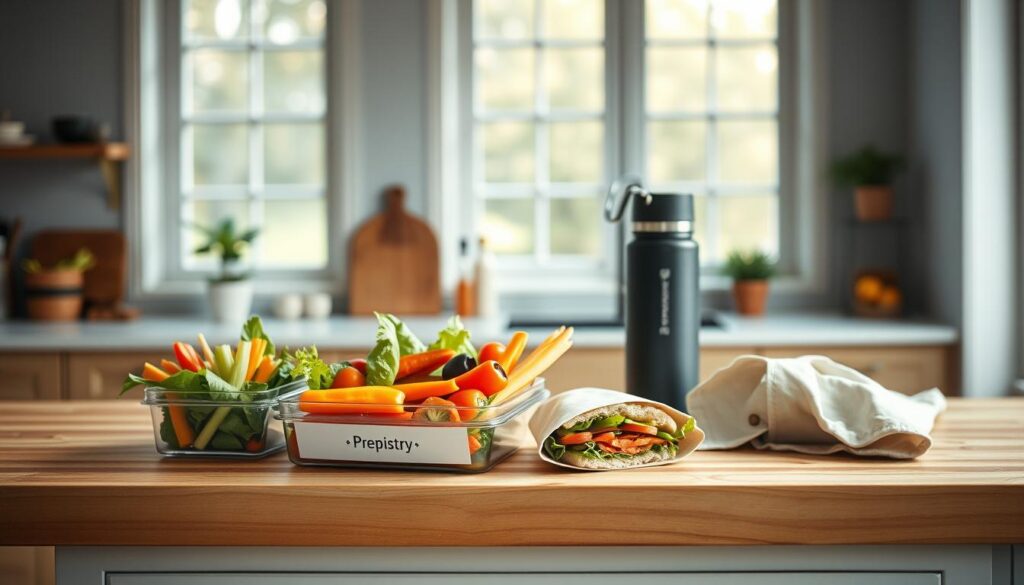
When the Clock Starts Ticking
Four hours unrefrigerated is your safety threshold. Beyond that? Freezer time. For example:
- Rice dishes: 2 hours max at room temp → freeze immediately after
- Chopped salads: 3 hours → transfer dressing to separate container
My personal rule? If I can’t reheat it to 165°F within minutes, it becomes tomorrow’s freezer stash. Reheating isn’t just about taste—it’s your final safety net.
Smart Strategies for Storing and Packaging Prepped Meals
We’ve all unearthed a mystery container from the back of the fridge. Was that spinach from Tuesday or last month? Let’s transform chaotic storage into a streamlined system that keeps your creations fresh and frustration-free.
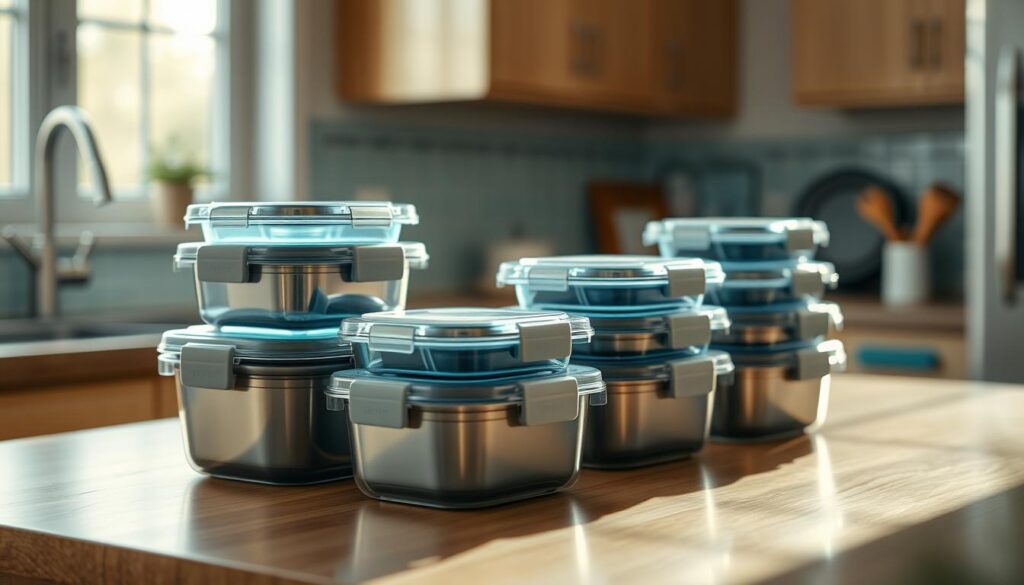
Choosing Airtight Containers and Proper Labeling
Your containers are the bodyguards of freshness. I learned this after a leaked dressing incident ruined my work bag. Glass options like 4-cup green-plastic food containers with locking lids prevent spills and temperature swings. For salads, wide-mouth mason jars keep greens crisp when layered properly.
Label smarter with three details:
- Dish name (e.g., “Lemon Herb Chicken”)
- Prep date (MM/DD)
- Reheating instructions (“Microwave 2 mins, stir”)
Utilizing the First-In, First-Out (FIFO) Method
Restaurant kitchens use this rotation system for good reason. Here’s how to adapt it:
- Place newest meals behind older ones
- Designate a “Eat First” shelf zone
- Freeze anything unused by day 4
| Container Type | Best For | Freezer Safe? | Max Storage |
|---|---|---|---|
| Glass with Locking Lid | Sauces, proteins | Yes | 3 months |
| Shallow Plastic | Rice, grains | No | 4 days |
| Mason Jars | Layered salads | Yes | 1 week |
Batch cooking becomes cost-effective when you maximize oven space. Roast veggies on one tray while chicken bakes beside it. This approach cut my energy bills by 15% last quarter. As I tell my cooking class students: “Good storage turns ingredients into investments.”
Optimizing Meal Prepping: Time, Money, and Nutritional Benefits
My kitchen used to resemble a chaotic pantry raid every evening—until batch cooking became my weekly reset button. Nutritional therapist Mimi Harrison showed me how £20 could stretch into 15 meals through strategic ingredient swaps like lentils for ground meat. This approach transformed my relationship with cooking from frantic to intentional.

Batch Cooking and Economic Savings
Sunday afternoons now mean roasting trays of colorful vegetables alongside versatile proteins. Farro with confetti veggies and vegetarian shepherd’s pie freeze beautifully for nutritious make-ahead options. Harrison’s method proves smart planning beats impulse buys:
- Bulk purchases reduce per-meal costs by 40%
- Oven-full cooking sessions slash energy use
- Pre-portioned containers prevent overeating
I’ve found roasted chicken thighs last four days when stored properly, while blanched greens stay crisp in airtight jars. “Think of your freezer as a flavor time capsule,” says chef educator Tomas Rivera. “Soups and stews develop richer tastes during their chilly hibernation.”
Batch cooking’s secret power? It turns decision fatigue into delicious efficiency. When my fridge holds ready-to-assemble components, I’m more likely to reach for roasted sweet potatoes than snack bags. The key is keeping basics like cooked grains and proteins neutral—season them differently each day to avoid taste burnout.
“Meal rhythm matters more than perfection. Three balanced components beat one Instagram-worthy dish that stresses you out.”
Start simple: double your favorite soup recipe next week. Freeze half, and notice how reclaiming 15 daily minutes feels sweeter than any takeout.
Your journey toward stress-free nourishment starts with small, intentional steps. I’ve burned rice, forgotten labels, and learned that glass containers truly are spill-proof heroes. But here’s the secret: Progress beats perfection every time.
Remember these core principles for success:
Cool cooked items completely before sealing—spread grains thinly or use ice baths for proteins. Rotate older portions to the front of your fridge using the FIFO method, and freeze anything you won’t eat within four days. Batch cooking isn’t just economical; it’s your ticket to reclaiming evenings and reducing last-minute decisions.
Embrace flexibility. That “Eat First” shelf in your fridge? It’s permission to pivot when cravings strike. Pair roasted veggies from Sunday with fresh greens midweek, or repurpose shredded chicken into wraps using morning routine strategies.
Share your wins (and mishaps) with our Prepistry community. We’re all refining our kitchen rhythms together. Because when you master smart storage and simple systems, you create space for what matters—nourishing meals and more moments to savor them.
Lemon-Dill Chickpea Orzo Jar Salad
A refreshing and protein-packed salad featuring orzo pasta, chickpeas, crisp vegetables, and a zesty lemon-dill dressing, perfect for on-the-go lunches or picnics.
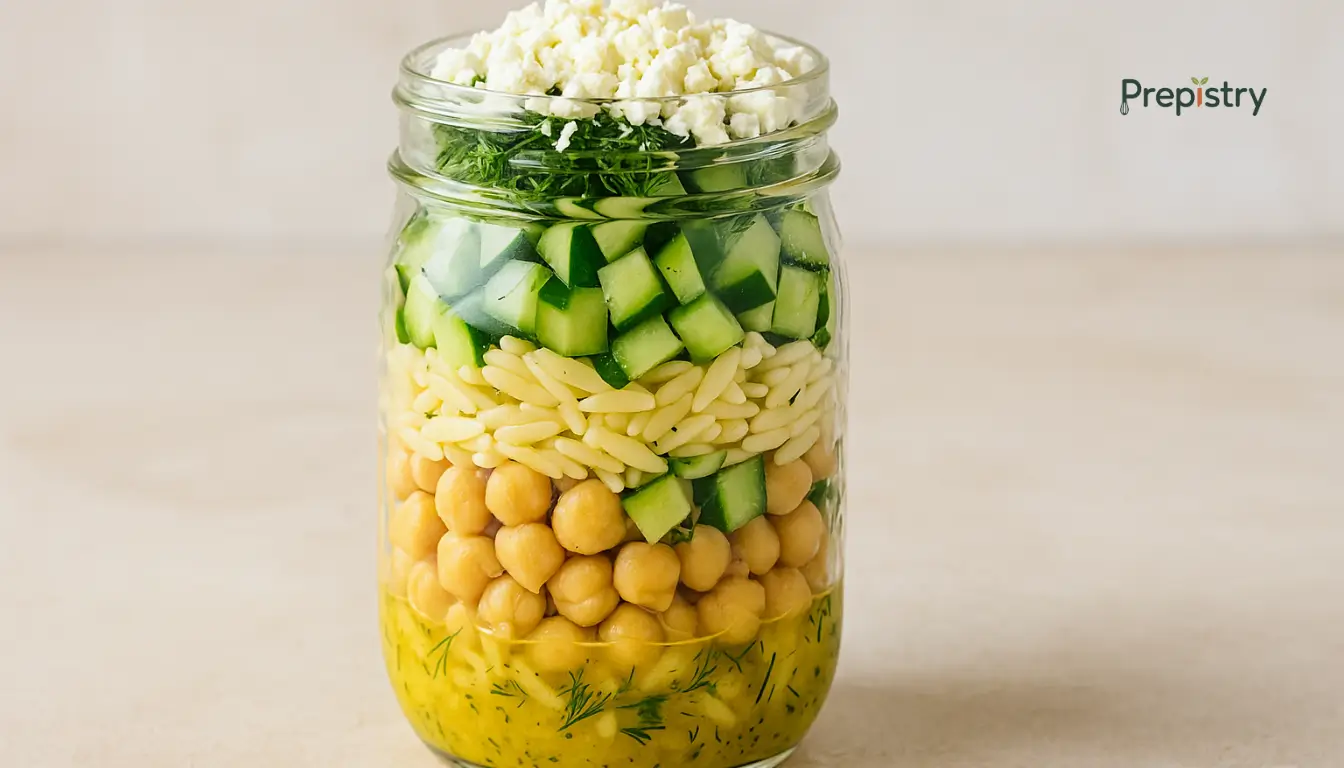
Nutrition Information
Equipment Needed
- Medium saucepan
- Mixing bowl
- Mason jars with lids
- Whisk
Ingredients
-
1 cup uncooked orzo pasta
-
1 can (15 oz) chickpeas, drained and rinsed
-
1 cup cherry tomatoes, halved
-
1 cup cucumber, diced
-
1/4 cup red onion, finely chopped
-
1/4 cup fresh dill, chopped
-
1/4 cup feta cheese, crumbled (optional)
-
2 tablespoons olive oil
-
2 tablespoons fresh lemon juice
-
1 teaspoon lemon zest
-
1 teaspoon Dijon mustard
-
Salt and pepper to taste
Instructions
Recipe Video
Lemon-Dill Chickpea Orzo Jar Salad Recipe
Learn how to prepare a delicious and healthy Lemon-Dill Chickpea Orzo Jar Salad, perfect for meal prep and on-the-go lunches.

